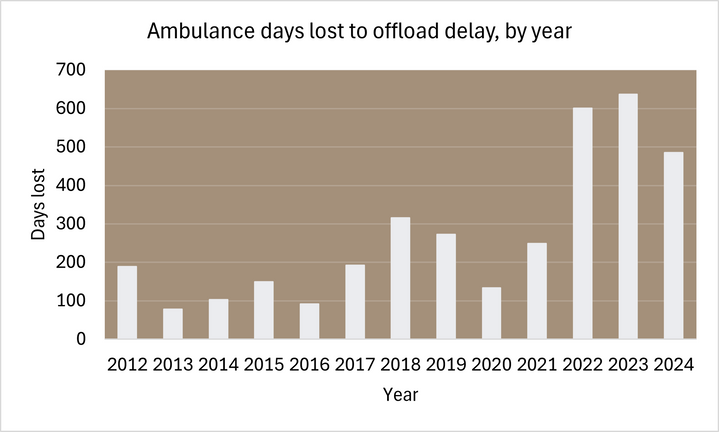PDSA
The Problem
The charts and table were prepared using data from the Region of Waterloo Paramedic Services' Performance Measurement Reports (2016–2024) and MBN Canada's Emergency Medical Services Performance Report (2015–2021) [11-17], [22-30], [32-35], [37].
Recent data from our region’s emergency medical services highlight a growing issue of ambulance offload delays and the resulting impact on EMS availability.
Offload Delays
Two charts below illustrate this trend. The first shows annual ambulance days lost due to offload delays, which have risen significantly over the past decade. The second chart tracks monthly totals and a 12-month moving average, confirming a steady upward slope in lost ambulance time. This indicates that paramedics are spending more hours waiting to transfer patients to hospital care instead of returning to service. The recent addition of more ambulances and paramedic staff, along with CMH's focus on reducing delays, has improved the statistics for 2024 compared to 2023, but delays remain a significant issue [3]. Moreover, when accounting for lost service time, 486 lost days—equivalent to nearly 972 twelve‑hour shifts for paramedic pairs—represent a lost wage value of approximately $860,000 to $1.02 million, based on 2020 wage rates of $36.84–$43.87 per hour [31].
Code Red & Code Yellow Events
The accompanying table further underscores the problem by detailing Code Red and Code Yellow occurrences over several years. Both event types reflect critical shortages in ambulance availability:
-
Code Red (recently renamed Code Zero): No ambulances are available in the region to respond to new calls.
-
Code Yellow (recently retired code): Only a minimal number of vehicles remain (three or less), raising the risk of entering a Code Red scenario.
Together, these data points show a systemic strain on EMS resources. More frequent and prolonged offload delays not only hinder timely patient care but also escalate the number of Code Red/Yellow events, potentially compromising the region’s overall emergency response capacity.


